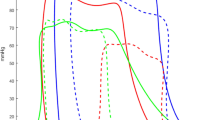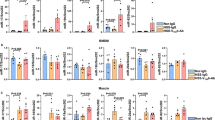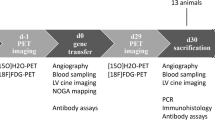Abstract
The development of clinically beneficial myocardial gene therapy has been slowed by reliance on the use of viral carriers and non-physiologic, constitutive gene expression. To specifically address these issues, we have developed a non-viral gene carrier, water-soluble lipopolymer (WSLP), and an ischemia-inducible plasmid construct expressing vascular endothelial growth factor (VEGF), pRTP801-VEGF, to treat myocardial ischemia and infarction. Rabbits underwent ligation of the circumflex artery followed by injection of (a) an ischemia-inducible VEGF gene construct in a WSLP carrier; (b) a constitutively expressed, or unregulated, SV-VEGF gene construct in a WSLP carrier; (c) WSLP carrier alone; or (d) no injection therapy. Following 4 weeks treatment, ligation alone resulted in infarction of 48±7% of the left ventricle. With injection of WSLP carrier alone, 49±6% of the left ventricle was infarcted (P=NS). The constitutively expressed gene construct, SV-VEGF, reduced the infarct size to 32±7% of the left ventricle (P=0.007). The ischemia-inducible gene construct, RTP801-VEGF, further reduced the infarct size to 13±4% of the left ventricle (P<0.001). The use of a non-viral carrier to deliver an ischemia-inducible VEGF construct is effective in the treatment of acutely ischemic myocardium.
This is a preview of subscription content, access via your institution
Access options
Subscribe to this journal
Receive 6 print issues and online access
$259.00 per year
only $43.17 per issue
Buy this article
- Purchase on SpringerLink
- Instant access to full article PDF
Prices may be subject to local taxes which are calculated during checkout







Similar content being viewed by others
References
Lee LY, Patel SR, Hackett NR, Mack CA, Polce DR, El-Sawy T et al. Focal angiogen therapy using intramyocardial delivery of an adenovirus vector coding for vascular endothelial growth factor 121. Ann Thorac Surg 2000; 69: 14–23; discussion 23–24.
Nakamura T, Mizuno S, Matsumoto K, Sawa Y, Matsuda H, Nakamura T . Myocardial protection from ischemia/reperfusion injury by endogenous and exogenous HGF. J Clin Invest 2000; 106: 1511–1519.
Rosengart TK, Lee LY, Patel SR, Sanborn TA, Parikh M, Bergman GW et al. Angiogenesis gene therapy: phase I assessment of direct intramyocardial administration of an adenovirus vector expressing VEGF121 cDNA to individuals with clinically significant severe coronary artery disease. Circulation 1999; 100: 468–474.
Symes JF, Losordo DW, Vale PR, Lathi KG, Esakof DD, Mayskiy M et al. Gene therapy with vascular endothelial growth factor for inoperable coronary artery disease. Ann Thorac Surg 1999; 68: 830–836; discussion 836–837.
Goncalves LM . Angiogenic growth factors: potential new treatment for acute myocardial infarction? Cardiovasc Res 2000; 45: 294–302.
Hao X, Mansson-Broberg A, Grinnemo KH, Siddiqui AJ, Dellgren G, Brodin LA et al. Myocardial angiogenesis after plasmid or adenoviral VEGF-A(165) gene transfer in rat myocardial infarction model. Cardiovasc Res 2007; 73: 481–487.
Ruixing Y, Jiaquan L, Jie C, Dezhai Y . Intravenous administration of vascular endothelial growth factor improves cardiac performance and inhibits cardiomyocyte apoptosis. Growth Factors 2006; 24: 209–217.
Luo Z, Diaco M, Murohara T, Ferrara N, Isner JM, Symes JF . Vascular endothelial growth factor attenuates myocardial ischemia–reperfusion injury. Ann Thorac Surg 2007; 64: 993–998.
Spyridopoulos I, Brogi E, Kearney M, Sullivan AB, Cetrulo C, Isner JM et al. Vascular endothelial growth factor inhibits endothelial cell apoptosis induced by tumor necrosis factor-alpha: balance between growth and death signals. J Mol Cell Cardiol 1997; 29: 1321–1330.
Giordano FJ, Gerber HP, Williams SP, VanBruggen N, Bunting S, Ruiz-Lozano P et al. A cardiac myocyte vascular endothelial growth factor paracrine pathway is required to maintain cardiac function. Proc Natl Acad Sci USA 2001; 98: 5780–5785.
Yoon YS, Uchida S, Masuo O, Cejna M, Park JS, Gwon HC et al. Progressive attenuation of myocardial vascular endothelial growth factor expression is a seminal event in diabetic cardiomyopathy: restoration of microvascular homeostasis and recovery of cardiac function in diabetic cardiomyopathy after replenishment of local vascular endothelial growth factor. Circulation 2005; 111: 2073–2085.
Bull DA, Bailey SH, Rentz JJ, Zebrack JS, Lee M, Litwin SE et al. Effect of Terplex/VEGF-165 gene therapy on left ventricular function and structure following myocardial infarction. VEGF gene therapy for myocardial infarction. J Control Release 2003; 93: 175–181.
Celletti FL, Waugh JM, Amabile PG, Brendolan A, Hilfiker PR, Dake MD . Vascular endothelial growth factor enhances atherosclerotic plaque progression. Nat Med 2001; 7: 425–429.
Lee RJ, Springer ML, Blanco-Bose WE, Shaw R, Ursell PC, Blau HM . VEGF gene delivery to myocardium: deleterious effects of unregulated expression. Circulation 2000; 102: 898–901.
Schwarz ER, Speakman MT, Patterson M, Hale SS, Isner JM, Kedes LH et al. Evaluation of the effects of intramyocardial injection of DNA expressing vascular endothelial growth factor (VEGF) in a myocardial infarction model in the rat—angiogenesis and angioma formation. J Am Coll Cardiol 2000; 35: 1323–1330.
Lee M, Bikram M, Oh S, Bull DA, Kim SW . Sp1-dependent regulation of the RTP801 promoter and its application to hypoxia-inducible VEGF plasmid for ischemic disease. Pharm Res 2004; 21: 736–741.
Crottogini A, Meckert P, Vera Janavel G, Lascano E, Negroni J, Del Valle H et al. Arteriogenesis induced by intramyocardial vascular endothelial growth factor 165 gene transfer in chronically ischemic pigs. Hum Gene Ther 2003; 14: 1307–1318.
Laguens R, Cabeza Meckert P, Vera Janavel G, De Lorenzi A, Lascano E, Negroni J et al. Cardiomyocyte hyperplasia after plasmid-mediated vascular endothelial growth factor gene transfer in pigs with chronic myocardial ischemia. Gene Med 2004; 6: 222–227.
Vera Janavel G, Crottogini A, Cabeza Meckert P, Cuniberti L, Mele A, Papouchado M et al. Plasmid-mediated VEGF gene transfer induces cardiomyogenesis and reduces myocardial infarct size in sheep. Gene Therapy 2006; 13: 1133–1142.
Zygalaki E, Kaklamanis L, Nikolaou NI, Kyrzopoulos S, Houri M, Kyriakides Z et al. Expression profile of total VEGF, VEGF slice variants and VEGF receptors in the myocardium and arterial vasculature of diabetic and non-diabetic patients with coronary artery disease. Clin Biochem 2008; 41: 82–87.
Sasso F, Torella D, Carbonara O, Ellison G, Torella M, Scardone M et al. Increased vascular endothelial growth factor expression but impaired vascular endothelial growth factor receptor signaling in the myocardium of type 2 diabetic patients with chronic coronary heart disease. J Am Coll Cardiol 2005; 46: 827–834.
Forsythe JA, Jiang BH, Iyer NV, Agani F, Leung SW, Koos RD et al. Activation of vascular endothelial growth factor gene transcription by hypoxia-inducible factor 1. Mol Cell Biol 1996; 16: 4604–4613.
Levy AP, Levy NS, Wegner S, Goldberg MA . Transcriptional regulation of the rat vascular endothelial growth factor gene by hypoxia. J Biol Chem 1995; 270: 13333–13340.
Liu Y, Cox SR, Morita T, Kourembanas S . Hypoxia regulates vascular endothelial growth factor gene expression in endothelial cells. Identification of a 5′ enhancer. Circ Res 1995; 77: 638–643.
Dibbens JA, Miller DL, Damert A, Risau W, Vadas MA, Goodall GJ . Hypoxic regulation of vascular endothelial growth factor mRNA stability requires the cooperation of multiple RNA elements. Mol Biol Cell 1999; 10: 907–919.
Lee M, Choi D, Choi MJ, Jeong JH, Kim WJ, Oh S et al. Hypoxia-inducible gene expression system using the erythropoietin enhancer and 3′-untranslated region for the VEGF gene therapy. J Control Release 2006; 115: 113–119.
Stein I, Neeman M, Shweiki D, Itin A, Keshet E . Stabilization of vascular endothelial growth factor mRNA by hypoxia and hypoglycemia and coregulation with other ischemia-induced genes. Mol Cell Biol 1995; 15: 5363–5368.
Nakagawa K, Chen YX, Ishibashi H, Yonemitsu Y, Murata T, Hata Y et al. Angiogenesis and its regulation: roles of vascular endothelial cell growth factor. Semin Thromb Hemost 2000; 26: 61–66.
Tang MX, Szoka FC . The influence of polymer structure on the interactions of cationic polymers with DNA and morphology of the resulting complexes. Gene Therapy 1997; 4: 823–832.
Rabinowitz JE, Samulski J . Adeno-associated virus expression systems for gene transfer. Curr Opin Biotechnol 1998; 9: 470–475.
Robbins PD, Ghivizzani SC . Viral vectors for gene therapy. Pharmacol Ther 1998; 80: 35–47.
Abdallah B, Goula D, Ghorbel M, Guissouma H, Benoist C, Seugnet I et al. Nonviral gene transfer for studying signaling in comparative developmental biology. Ann N Y Acad Sci 1998; 839: 87–92.
Hacein-Bey-Abina S, Von Kalle C, Schmidt M, McCormack MP, Wulffraat N, Leboulch P et al. LMO2-associated clonal T cell proliferation in two patients after gene therapy for SCID-X1. Science 2003; 302: 415–419.
Hollon T . Researchers and regulators reflect on first gene therapy death. Nat Med 2000; 6: 6.
Nakamura T, Mizuno S, Matsumoto K, Sawa Y, Matsuda H, Nakamura T . Myocardial protection from ischemia/reperfusion injury by endogenous and exogenous HGF. J Clin Invest 2000; 106: 1511–1519.
Harvey BG, Hackett NR, El-Sawy T, Rosengart TK, Hirschowitz EA, Lieberman MD et al. Variability of human systemic humoral immune responses to adenovirus gene transfer vectors administered to different organs. J Virol 2000; 73: 6729–6742.
SoRelle R . Shaking the world of gene therapy. Circulation 2000; 101: E9052–E9053.
Cristiano RJ, Roth JA . Molecular conjugates: a targeted gene delivery vector for molecular medicine. J Mol Med 1995; 73: 479–486.
Felgner P, Zelphati O, Liang X . Advances in Synthetic Gene-Delivery System, the Development of Human Gene Therapy. Cold Spring Harbor Laboratory Press: New York, 2000.
Godbey WT, Wu KK, Mikos AG . Size matters: molecular weight affects the efficiency of poly(ethylenimine) as a gene delivery vehicle. J Biomed Mater Res 1999; 45: 268–275.
Gao X, Huang L . A novel cationic liposome reagent for efficient transfection of mammalian cells. Biochem Biophys Res Commun 1999; 179: 280–285.
Gill DR, Southern KW, Mofford KA, Seddon T, Huang L, Sorgi F et al. A placebo-controlled study of liposome-mediated gene transfer to the nasal epithelium of patients with cystic fibrosis. Gene Therapy 1997; 4: 199–209.
Nabel GJ, Nabel EG, Yang ZY, Fox BA, Plautz GE, Gao X et al. Direct gene transfer with DNA–liposome complexes in melanoma: expression, biologic activity, and lack of toxicity in humans. Proc Natl Acad Sci USA 1993; 90: 11307–11311.
Lee M, Rentz J, Bikram M, Han SO, Bull DA, Kim SW . Hypoxia-inducible VEGF gene delivery to ischemic myocardium using water-soluble lipopolymer. Gene Ther 2003; 10: 1535–1542.
Lee M, Rentz J, Han SO, Bull DA, Kim SW . Water-soluble lipopolymer as an efficient carrier for gene delivery to myocardium. Gene Therapy 2003; 10: 585–593.
Janat-Amsbury MM, Yockman JW, Lee M, Kern S, Furgeson DY, Bikram M et al. Combination of local, nonviral IL12 gene therapy and systemic paclitaxel treatment in a metastatic breast cancer model. Mol Ther 2004; 9: 829–836.
Lee M, Ryu JK, Oh SM, Lee E, Shin HY, Song SU et al. Water-soluble lipopolymer as a gene carrier to corpus cavernosum. Int J Impot Res 2007; 17: 326–334.
Yockman JW, Kim WJ, Chang CW, Kim SW . Non-viral delivery of interleukin-2 and soluble Flk-1 inhibits metastatic and primary tumor growth in renal cell carcinoma. Gene Therapy 2007; 14: 1399–1405.
Yockman JW, Maheshwari A, Han SO, Kim SW . Tumor regression by repeated intratumoral delivery of water-soluble lipopolymers/p2CMVmIL-12 complexes. J Control Release 2003; 87: 177–186.
Acknowledgements
This work was supported by NIH Grants HL071541 (DAB) and HL65477 (SWK).
Author information
Authors and Affiliations
Corresponding author
Rights and permissions
About this article
Cite this article
Yockman, J., Choi, D., Whitten, M. et al. Polymeric gene delivery of ischemia-inducible VEGF significantly attenuates infarct size and apoptosis following myocardial infarct. Gene Ther 16, 127–135 (2009). https://doi.org/10.1038/gt.2008.146
Received:
Revised:
Accepted:
Published:
Issue date:
DOI: https://doi.org/10.1038/gt.2008.146
Keywords
This article is cited by
-
Cardiac aorta-derived extracellular matrix scaffold enhances critical mediators of angiogenesis in isoproterenol-induced myocardial infarction mice
Journal of Materials Science: Materials in Medicine (2021)
-
Gene delivery of hypoxia-inducible VEGF targeting collagen effectively improves cardiac function after myocardial infarction
Scientific Reports (2017)
-
Hypoxia-Sensitive Materials for Biomedical Applications
Annals of Biomedical Engineering (2016)
-
Emulsion electrospun nanofibers as substrates for cardiomyogenic differentiation of mesenchymal stem cells
Journal of Materials Science: Materials in Medicine (2013)
-
Hypoxia-inducible Vascular Endothelial Growth Factor-engineered Mesenchymal Stem Cells Prevent Myocardial Ischemic Injury
Molecular Therapy (2011)



